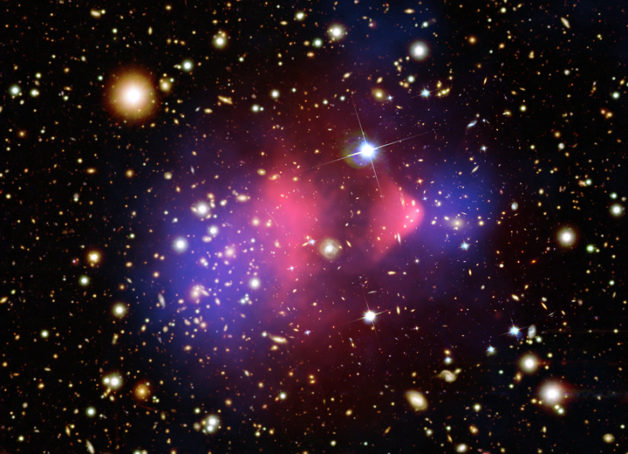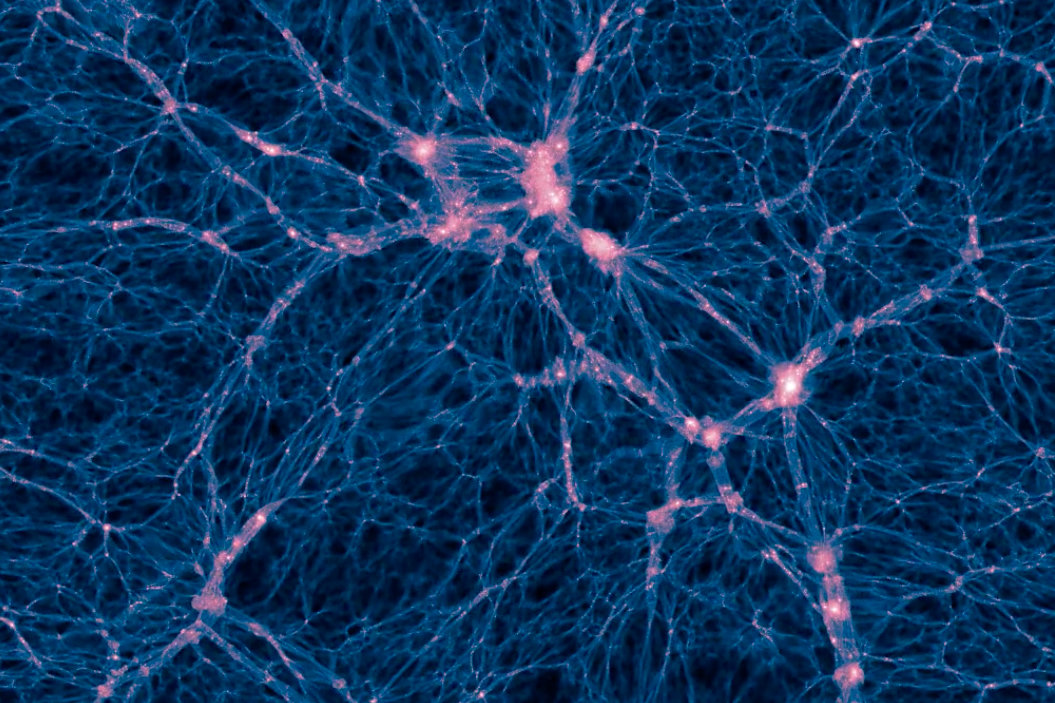VIDEO: Animated projection of the dark matter density distribution in the universe. (Credit: Illustris Collaboration/Illustris Simulation)
A global hunt for the universe’s missing matter is underway, and this autumn everyone is invited to join in. On and around October 31, 2017, events around the world will celebrate the hunt for the universe’s unseen “dark matter.” Dark Matter Day events will engage the public in discussions about dark matter, and about the many experiments that seek to solve its mysteries.
Researchers at the Department of Energy’s Lawrence Berkeley National Laboratory (Berkeley Lab) are active participants in the search for dark matter. Berkeley Lab has a lead role in the LUX-ZEPLIN (LZ) experiment, for example, that will seek out dark matter particles using mile-deep detectors.

This image shows a cutaway rendering of the LUX-ZEPLIN (LZ) detector that will search for dark matter nearly a mile below ground. An array of detectors, known as photomultiplier tubes, at the top and bottom of the liquid xenon tank are designed to pick up particle signals. (Credit: Matt Hoff/Berkeley Lab)
Berkeley Lab also has roles in several other experiments that could lead to new clues about dark matter, including: the ATLAS experiment at CERN laboratory in Switzerland; the Dark Energy Spectroscopic Instrument (DESI) project; and the Chile-based POLARBEAR, Simons Array, and Simons Observatory sky surveys. Berkeley Lab researchers are also working to develop new theories about dark matter that can inform experiments on where to look for dark matter, and what to look for.
Universities, laboratories, institutions and individuals are invited to help promote this international scientific quest by organizing Dark Matter Day events in their area or online. Events could include a public lecture on dark matter, a tour of a science laboratory or experiment connected with the search for dark matter, a dark matter-themed planetarium show or film presentation, Q&A with a scientist live or online, classroom presentation … the sky is the limit.
The darkmatterday.com website includes resources that can help you find and connect with local dark matter experts, plan a program for a particular audience, and promote and share your events with the world.
Just want to attend an event? You don’t need a PhD to explore dark matter’s mysteries – just curiosity. Anyone who wants to learn about dark matter – adults, kids, non-scientists, scientists, science educators, students – is encouraged to attend local Dark Matter Day events on or leading up to October 31, 2017. Go to darkmatterday.com to sign up to be notified of events near you.
Check out some of the other offerings at darkmatterday.com:
- A Dark Matter Day FAQ to answer your questions about the purpose of this premier effort.
- An Event Starter Kit to help plan a Dark Matter Day event yourself.
- A Submit an Event form to let us know about your event so we can help spread the word.
- A Find an Event feature so we can let you know about upcoming Dark Matter Day events near you.
What is dark matter?
Dark matter explains how galaxies spin at a faster-than-expected rate without coming apart. Scientists know from these and other space observations that there is “missing” mass – something we can’t see – that makes up an estimated 85 percent of the total mass of the universe. So a big part of the universe is largely unknown to us.
Finding out what dark matter is made of is a pressing pursuit in physics. We don’t yet know if it’s composed of undiscovered particles or whether it requires some other change in our understanding of the universe’s laws of physics. A host of innovative experiments are searching for the source of dark matter using different types of tools, such as mile-deep detectors, powerful particle beams, and space-based and ground-based telescopes.

A composite image of the “bullet cluster,” a galaxy cluster formed by a collision of two clusters. The pink clumps show hot gas containing most of the normal matter, while the two blue clumps reveal where most of the mass in the clusters is actually contained. This provides evidence for dark matter since most of the mass was expected to be concentrated around the pink areas. (Credit: X-ray image by NASA/CXC/M.Markevitch et al.; optical image by NASA/STScI, Magellan/U.Arizona/D.Clowe et al.; lensing map image by NASA/STScI, ESO WFI, Magellan/U.Arizona/D.Clowe et al.)
Why is there a day dedicated to dark matter?
Revealing dark matter’s true nature will tell us a lot about the origins, evolution, and overall structure in the universe, and will reshape our understanding of physics.
Dark Matter Day events are intended to educate the public about the importance of learning all we can about dark matter to develop a fuller picture of the unseen universe. Focusing more brainpower and scientific resources on dark matter’s mysteries could lead to new ideas and new discoveries.
Who is behind Dark Matter Day?
This first-ever Dark Matter Day campaign was conceived by the Interactions Collaboration, a group of science communicators representing the world’s particle physics laboratories. The collaboration also runs the darkmatterday.com website as a resource for people who want to host or attend local Dark Matter Day events.
VIDEO: Formation of the cosmic web: A dark matter visualization. (Credit: KIPAC/SLAC)
Need more help?
Members of the Interactions Collaboration want you to be a part of Dark Matter Day. Please send an email to [email protected] with any questions, comments, or suggestions. If you are seeking a dark matter expert from Berkeley Lab to participate in a Dark Matter Day event, please send an email to [email protected] or call (510) 486-5582.
Note: This release was adapted from the original release distributed by the Interactions Collaboration. View the original release here.
###
Lawrence Berkeley National Laboratory addresses the world’s most urgent scientific challenges by advancing sustainable energy, protecting human health, creating new materials, and revealing the origin and fate of the universe. Founded in 1931, Berkeley Lab’s scientific expertise has been recognized with 13 Nobel Prizes. The University of California manages Berkeley Lab for the U.S. Department of Energy’s Office of Science. For more, visit www.lbl.gov.
DOE’s Office of Science is the single largest supporter of basic research in the physical sciences in the United States, and is working to address some of the most pressing challenges of our time. For more information, please visit science.energy.gov.
The Interactions Collaboration (Interactions.org) seeks to support the international science of particle physics and to set visible footprints for peaceful collaboration across all borders. The www.darkmatter.com website was developed and is jointly maintained by the Interactions Collaboration, whose members represent the world’s particle physics laboratories and institutions in Europe, North America, Asia, and Australia, with funding provided by science funding agencies from many nations.
